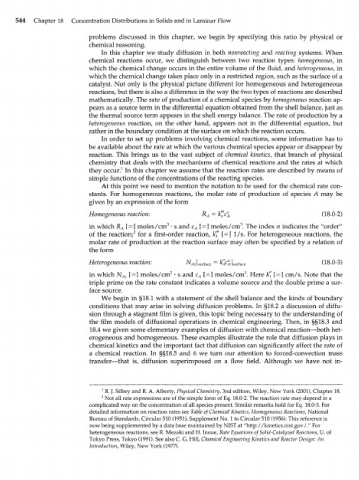Page 564 - Bird R.B. Transport phenomena
P. 564
544 Chapter 18 Concentration Distributions in Solids and in Laminar Flow
problems discussed in this chapter, we begin by specifying this ratio by physical or
chemical reasoning.
In this chapter we study diffusion in both nonreacting and reacting systems. When
chemical reactions occur, we distinguish between two reaction types: homogeneous, in
which the chemical change occurs in the entire volume of the fluid, and heterogeneous, in
which the chemical change takes place only in a restricted region, such as the surface of a
catalyst. Not only is the physical picture different for homogeneous and heterogeneous
reactions, but there is also a difference in the way the two types of reactions are described
mathematically. The rate of production of a chemical species by homogeneous reaction ap-
pears as a source term in the differential equation obtained from the shell balance, just as
the thermal source term appears in the shell energy balance. The rate of production by a
heterogeneous reaction, on the other hand, appears not in the differential equation, but
rather in the boundary condition at the surface on which the reaction occurs.
In order to set up problems involving chemical reactions, some information has to
be available about the rate at which the various chemical species appear or disappear by
reaction. This brings us to the vast subject of chemical kinetics, that branch of physical
chemistry that deals with the mechanisms of chemical reactions and the rates at which
they occur. 1 In this chapter we assume that the reaction rates are described by means of
simple functions of the concentrations of the reacting species.
At this point we need to mention the notation to be used for the chemical rate con-
stants. For homogeneous reactions, the molar rate of production of species A may be
given by an expression of the form
Homogeneous reaction: R A = k!"c A (18.0-2)
3
in which R A [=] moles/cm 3 • s and c A [=] moles/cm . The index n indicates the "order"
2
of the reaction; for a first-order reaction, k"' [ = ] 1/s. For heterogeneous reactions, the
molar rate of production at the reaction surface may often be specified by a relation of
the form
Heterogeneous reaction: N Az\ sur f acc = k!' nc A \ surf ace (18.0-3)
3
in which N Az 1=] moles/cm 2 • s and c A[=] moles/cm . Here k" [ = ] m/s. Note that the
c
triple prime on the rate constant indicates a volume source and the double prime a sur-
face source.
We begin in §18.1 with a statement of the shell balance and the kinds of boundary
conditions that may arise in solving diffusion problems. In §18.2 a discussion of diffu-
sion through a stagnant film is given, this topic being necessary to the understanding of
the film models of diffusional operations in chemical engineering. Then, in §§18.3 and
18.4 we given some elementary examples of diffusion with chemical reaction—both het-
erogeneous and homogeneous. These examples illustrate the role that diffusion plays in
chemical kinetics and the important fact that diffusion can significantly affect the rate of
a chemical reaction. In §§18.5 and 6 we turn our attention to forced-convection mass
transfer—that is, diffusion superimposed on a flow field. Although we have not in-
1
R. J. Silbey and R. A. Alberty, Physical Chemistry, 3nd edition, Wiley, New York (2001), Chapter 18.
2
Not all rate expressions are of the simple form of Eq. 18.0-2. The reaction rate may depend in a
complicated way on the concentration of all species present. Similar remarks hold for Eq. 18.0-3. For
detailed information on reaction rates see Table of Chemical Kinetics, Homogeneous Reactions, National
Bureau of Standards, Circular 510 (1951), Supplement No. 1 to Circular 510 (1956). This reference is
now being supplemented by a data base maintained by NIST at "http://kinetics.nist.gov/." For
heterogeneous reactions, see R. Mezaki and H. Inoue, Rate Equations of Solid-Catalyzed Reactions, U. of
Tokyo Press, Tokyo (1991). See also C. G. Hill, Chemical Engineering Kinetics and Reactor Design: An
Introduction, Wiley, New York (1977).

